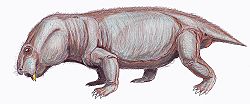| Australobarbarus Temporal range: Late Permian | |
|---|---|
 | |
| Skeleton in Natural History Museum of Helsinki, Finland | |
| Scientific classification | |
| Domain: | Eukaryota |
| Kingdom: | Animalia |
| Phylum: | Chordata |
| Clade: | Synapsida |
| Clade: | Therapsida |
| Suborder: | † Anomodontia |
| Clade: | † Dicynodontia |
| Family: | † Oudenodontidae |
| Genus: | † Australobarbarus Kurkin, 2000 |
| Species | |
| |
Australobarbarus is a genus of dicynodont from Late Permian (Wuchiapingian) of Russia. [1]






